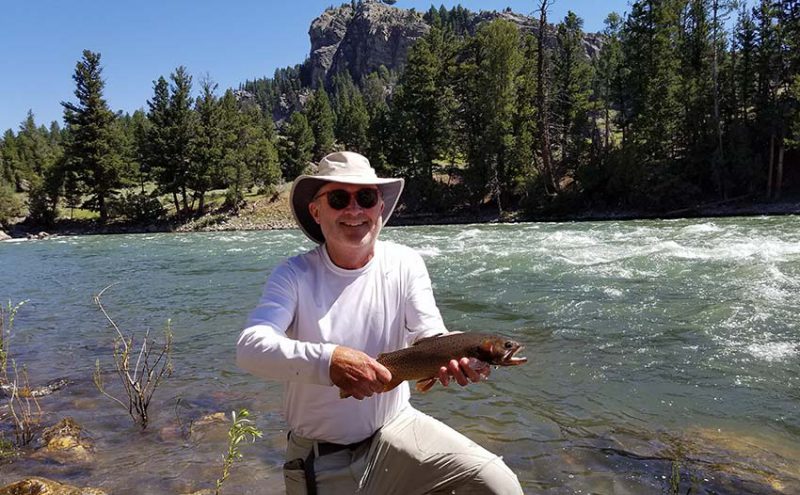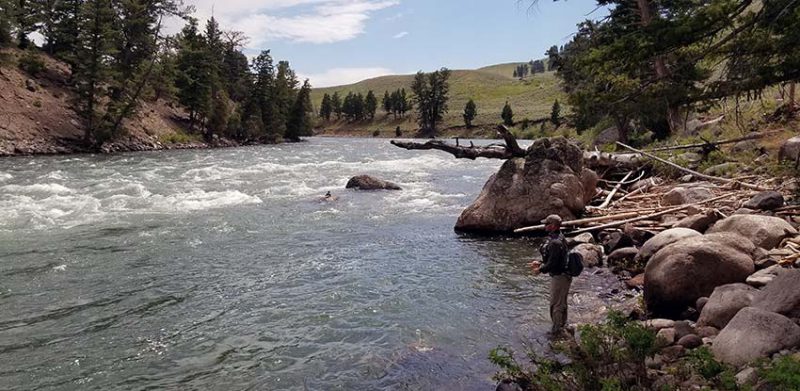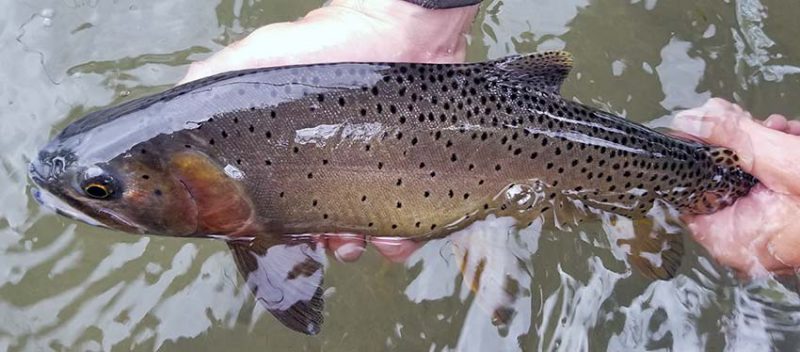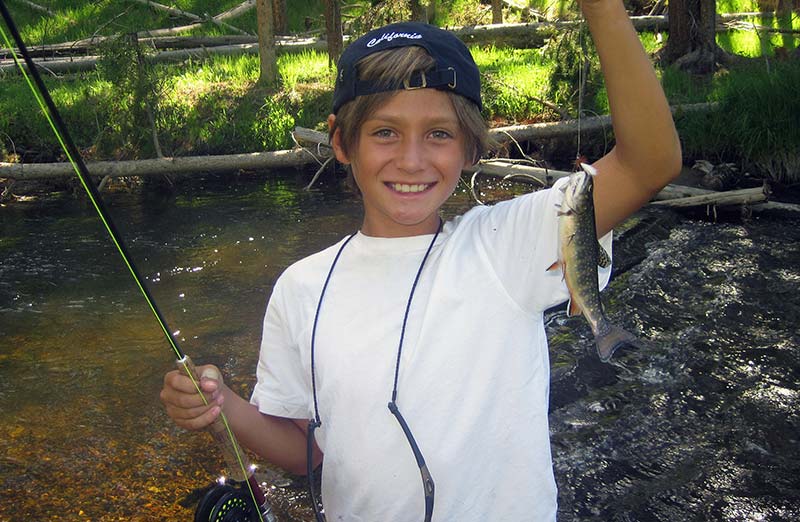Early Summer Yellowstone Fishing Trips
Posted on January 31st, 2021 in Uncategorized
Introduction to Early Summer Yellowstone Fishing Trips
Early summer (basically the month of July) is prime time for hike-in walk-wade fishing on all larger streams as well as many small creeks suitable for beginners and experts alike. This is a particularly good period for those eager to chase cutthroat trout on the Yellowstone River and rugged portions of the Lamar River and Slough Creek. It’s also a good bet for those hoping to hit the fabled Salmonfly hatches without the crowds that accompany this major hatch on rivers large enough for float trips.
On the other hand, this is also prime time for crowds, so to find good fishing or at least uncrowded fishing, hiking is basically required, and the hikes can be hot since this is also the hottest time of year.

July is prime time for those who want to make aggressive hikes. This angler is fishing the Black Canyon of the Yellowstone during the Salmonfly Hatch.
Early Summer Yellowstone Fishing Trips: Quick Facts
- Best Waters: The sky is the limit in early summer. Large and small rivers like the Yellowstone, Gardner, and Lamar are good now, as are all of their tributaries. On the west side of the park, the upper Gallatin is great. YCFF tends to focus on hike-in sections of the Yellowstone, Lamar and tributaries, and Gardner and tributaries. Only the Firehole, lower Gibbon, and Madison are poor at this time. They are too warm due to geyser discharge.
- Three Top Reasons to Come in Early Summer: 1.) Early summer offers the widest range of fishable waters in YNP, as well as the most consistent fishing overall. 2.) Except for occasional thunderstorms, the weather is at its most consistent during this period. 3.) This is the best time of year to match hatches in Yellowstone Park, from small mayflies on up to the fabled Salmonfly.
- Three Top Reasons to Avoid Early Summer: 1.) This is the most crowded time of year for both general tourism and anglers in the park. 2.) This is the hottest time of year, so hiking can sometimes be a sweaty affair. 3.) Rivers can still be high, so wading is tougher now than in late summer and fall.
- Perfect Clients: Early summer is ideal for adventurous, fit anglers eager to hike who are willing to put up with crowded roads and sometimes crowded rivers (even in the backcountry) in exchange for the most consistent fishing of the year, if not always the best fishing of the year.
- What Early Summer Does Best: Provides a huge range of fishing opportunities, from small fish in small streams to large cutthroat trout in big rivers.
July Trips: The Details
When the rivers across the northern portion of Yellowstone Park drop out of their spring runoff between the last week of June and the middle of July, options for walk-wade trips spike dramatically. The month or so following the end of the runoff offers the widest range of options for walk trips, especially for beginners, anglers who like to hike, and those who want to chase cutthroat trout.

This angler is fishing streamers in the Black Canyon of the Yellowstone. The hike to this area follows the sparse trees at top-center.
The best options for full-day trips for experienced anglers throughout this period are the Yellowstone in its Grand and Black Canyons and rugged portions of Slough Creek and the Lamar River. We’ll often put together a trip focusing on one of these waters for most of the day that concludes on the Gardner River or one of the fun, out-of-the-way small streams that becomes fishable at this time.
Because angler crowds are heavy near the roads in early summer, it is vitally important to hike to shed crowds. When possible, we also like to fish water with rugged banks and fast water, because such a stream character really deters the masses. The ultimate example of this type of water is found on the canyon sections of the Yellowstone, which explains why this is by far our favorite walk-in river for experienced anglers during the summer.

Fat, healthy Yellowstone cutthroat trout like this one are our primary quarry on many July Yellowstone fishing trips.
On July Yellowstone fishing trips, most Yellowstone River fishing inside the park revolves around the Salmonfly and Golden Stonefly hatch. While this hatch typically lasts only a week or ten days outside the park, it can last as much as a month inside it. These finger-length bugs can attract even the largest trout to the surface.
Even if they don’t want to rise, the fish will take big nymphs hung as droppers under large dry flies. When the fish want an “after dinner mint” instead of the main course, smaller attractor dries and attractor nymphs also work well, especially during caddisfly or Yellow Sally stonefly hatches.
Our Yellowstone fishing guides usually carry a spare rod rigged with streamers on the Yellowstone, and the streamers can be a blast to fish in the deep green pools found on this stretch of the Yellowstone. The trout here love to chase, and will often follow flies during the retrieve all the way to the rod tip before striking, making for the most visual streamer fishing we’ve ever found.

This large rainbow-cutthroat hybrid trout came from a rough section of Slough Creek on a July Yellowstone fishing trip.
Mayfly hatches are also excellent on certain waters during this period, particularly the Western Green Drake hatches which can get the fish really excited. These hatches are most common on the Lamar River and its main tributaries Slough Creek and Soda Butte Creek, as well as a few smaller streams.
For anglers interested in this match-the-hatch fishing, we typically guide on the rugged portions of the Lamar and Slough, as well as on a couple waters we won’t name online. These locations tend to hold split populations of trout, with a lot of small ones as well as a few great fish like the one in the photo above, rather than the medium-sized fish common in the meadow sections of the Lamar and its tributaries near the road, which see horrendous and overwhelming angler crowds at this time. This water is suitable for anglers of a variety of skill levels, provided they’re up for some rock-hopping.
Beginner options are great at this time. Enthusiastic beginners can do well on many small, rough streams holding cutthroat, rainbow, and brown trout. Those who want to be sure of catching a bunch of fish (though no big ones) should think about starting with a half-day on a small brook trout stream. Often a half-day on such a creek is enough, but many beginners like to combine a half-day on a brookie creek with an afternoon on more-challenging water on the Gardner or Yellowstone after lunch, trying to add a couple bigger, harder fish to the mix.
For families, July is the best period for our “beginner brookie” family trips, which are a cost-effective way to learn about fly fishing for groups of as many as five people.

Beginner angler with a brook trout caught on a July Yellowstone fishing trip.
Full-day and half-day trips are available at this time, though full-day trips provide time to get further into the park and take longer hikes. Most full-days will start between 6:00 and 8:00, depending on how far we’ll be hiking, while half-days will generally start around 8:00.